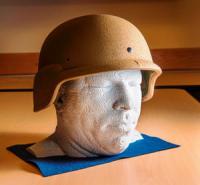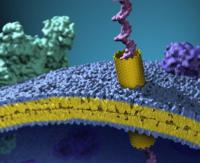-
CHEMICAL WARFAREA Protein Could Prevent Chemical Warfare Attack
A team of scientists has designed a synthetic protein that quickly detects molecules of a deadly nerve agent that has been classified by the United Nations as a weapon of mass destruction and could be used in a chemical warfare attack.
-
-
BODY ARMORFuzzy Nanoparticles: New Way to Design Tougher Ballistic Materials
Researchers have discovered a new method to improve the toughness of materials that could lead to stronger versions of body armor, bulletproof glass and other ballistic equipment.
-
-
ArmorNew Material Could Mean Lightweight Armor, Protective Coatings
Researchers identified a new material that may lead to lightweight armor, protective coatings, blast shields, and other impact-resistant structures.
-
-
Protective gearTaking a Cue from Nature to Create Bulletproof Coatings
Shrimp, lobsters and mushrooms may not seem like great tools for the battlefield, but three engineers from the University of Houston are using chitin – a derivative of glucose found in the cellular walls of arthropods and fungi – and 3D printing techniques to produce high-impact multilayered coatings that can protect soldiers against bullets, lasers, toxic gas and other dangers.
-
-
ExtremismLeader of British Far-Right Group Convicted under Terrorism Law
Paul Golding, 38, the leader of the British far-right political group Britain First, has been found guilty of an offense under the Terrorism Act after refusing to give police access to his mobile phone on his return from a political trip to Russia.
-
-
Protective gearBody Armor for Women in Law Enforcement
Law enforcement in the United States remains a male-dominated profession. According to recent reports, less than 13 percent of full-time officers are female. So, it stands to reason that the ballistic-resistant body armor worn by law enforcement officers in the field has traditionally been designed for the male build. As the number of women entering the field continues to rise, so too has the demand for personal protective equipment (PPE) that is designed for the female physique.
-
-
Protective gearWWI Helmets Protect Against Shock Waves as Well as or Better than Modern Designs
Biomedical engineers have demonstrated that, despite significant advancements in protection from ballistics and blunt impacts, modern military helmets are no better at protecting the brain from shock waves created by nearby blasts than their First World War counterparts. And one model in particular, the French Adrian helmet, actually performed better than modern designs in protecting from overhead blasts.
-
-
PerspectiveDARPA Wants Smart Suits to Protect Against Biological Attacks
DARPA, the Pentagon’s research arm, wants to accelerate the development of innovative textiles and smart materials to better and more comfortably protect humans from chemical and biological threats.
-
-
Personal protection gearBlast, impact simulations help researchers better understand injuries and body armor

Researchers at Sandia Lab have studied the mechanisms behind traumatic brain injury for about a decade. Their traumatic injury modeling and simulation project began with a head-and-neck representation, and now they’ve created a high-fidelity, digital model of a man from the waist up to study the minute mechanisms behind trauma. The specialized computer modeling and simulation methods help researchers better understand how blasts on a battlefield could lead to traumatic brain injury and injuries to vital organs, like the heart and lungs.
-
-
Body armorTesting polymer fibers for body armor
High-performance polymer fibers have been used in ballistics applications for more than forty years. Although effective at stopping or slowing down bullets, users have sometimes found these vests, which are worn either under or over clothing, to be heavy and bulky—akin to wearing 15 to 20 shirts at once on a hot summer day. Many would like a more comfortable alternative. NIST scientists have developed a new way to investigate the high-performance fibers used in modern body armor.
-
-
Personal protective equipmentBulletproof origami shield to protect law enforcement

Engineering professors have created an origami-inspired, lightweight bulletproof shield that can protect law enforcement from gunfire. The new barrier can be folded compactly when not in use, making it easier to transport and deploy. When expanded — which takes only five seconds — it can provide cover for officers and stop bullets from several types of handguns. The ballistic barrier is made of twelve layers of Kevlar.
-
-
Personal protection equipmentFish scales inspire protective wear
For several years, researchers have been trying to replicate the kind of protection combined with flexibility offered by certain kinds of animal scales. Their goal is to create protective gloves that are both resistant to piercing and still flexible enough. After five years of work, they believe they have done it. The solution came when they started looking more closely at the scales of an alligator gar.
-
-
Personal protective equipmentHair strength inspires new materials for body armor
In a new study, researchers investigate why hair is incredibly strong and resistant to breaking. The findings could lead to the development of new materials for body armor and help cosmetic manufacturers create better hair care products.
-
-
FirefightersThermal sensor provides warning for firefighter safety
The conditions inside a burning building are perilous and can change rapidly. For firefighters searching for people trapped within a burning building, these risks can be exacerbated in a matter of seconds as exposure to high temperature may cause their personal protective equipment (PPE) to fail. This is particularly true in the presence of infrared radiation, which can rapidly increase the temperature of a firefighter’s environment without warning. DHS S&T is now working with partners to develop the Burn Saver Thermal Sensor, a battery-powered device that will be carried by firefighters and detects thermal changes in their operating environments.
-
-
Personal protective equipment“Second skin” uniform protects soldiers from biological, chemical agents in the field

In work that aims to protect soldiers from biological and chemical threats, scientists have created a material that is highly breathable yet protective from biological agents. This material is the first key component of futuristic smart uniforms that also will respond to and protect from environmental chemical hazards.
-
- All
- Regional
- Water
- Biometrics
- Borders/Immig
- Business
- Cybersecurity
- Detection
- Disasters
- Government
- Infrastructure
- International
- Public health
- Public Safety
- Communication interoperabillity
- Emergency services
- Emergency medical services
- Fire
- First response
- IEDs
- Law Enforcement
- Law Enforcement Technology
- Military technology
- Nonlethal weapons
- Nuclear weapons
- Personal protection equipment
- Police
- Notification /alert systems
- Situational awareness
- Weapons systems
- Sci-Tech
- Sector Reports
- Surveillance
- Transportation
Advertising & Marketing: advertise@newswirepubs.com
Editorial: editor@newswirepubs.com
General: info@newswirepubs.com
2010-2011 © News Wire Publications, LLC News Wire Publications, LLC
220 Old Country Road | Suite 200 | Mineola | New York | 11501
Permissions and Policies
Editorial: editor@newswirepubs.com
General: info@newswirepubs.com
2010-2011 © News Wire Publications, LLC News Wire Publications, LLC
220 Old Country Road | Suite 200 | Mineola | New York | 11501
Permissions and Policies
